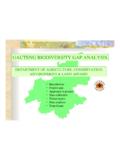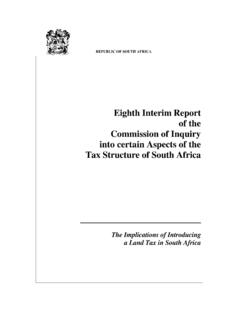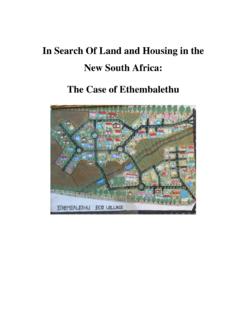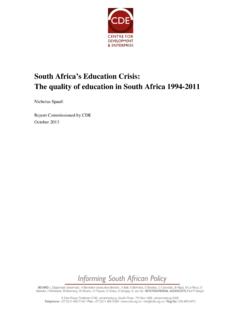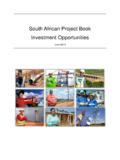Transcription of GAUTENG BIODIVERSITY GAP ANALYSIS - conservancies.org
1 GAUTENG BIODIVERSITY GAP ANALYSIS . DEPARTMENT OF AGRICULTURE, CONSERVATION, ENVIRONMENT & LAND AFFAIRS. ) Introduction ) Project aim ) Approach to project ) Data collection ) Threat layers ) Data ANALYSIS ) Time frame INTRODUCTION. Policy context ) south africa is a signatory to the United Nations Convention on Biological Diversity and is therefore committed to ensuring its objectives are met. ) The White Paper on the Conservation and Sustainable Use of south africa 's Biological Diversity describes south africa 's approach to upholding this Convention.
2 The BGAP addresses the first of the goals listed in the White Paper, to conserve the diversity of landscapes, ecosystems, habitats, communities, populations, species and genes in south africa . BIODIVERSITY defined LANDSCAPES. ) The variety and variability among living organisms and the ecological COMMUNITIES. complexes in which they occur. ) The term encompasses different levels of organization including landscapes, communities, species, yy populations, individual organisms y y y y SPECIES/. y y yy POPULATIONS. and genes. yy ) Ecological processes are also included.
3 INDIVIDUALS. GENES. BIODIVERSITY of GAUTENG ) Although the smallest province in SA, GAUTENG is characterized by a high BIODIVERSITY . ) GAUTENG falls within both the savanna and highly threatened grassland biomes that together constitute six vegetation types. ) Approximately 83% of the province falls within Highveld Grassland, of which an estimated is currently conserved in SA. ) An estimated 3303 plant species, 125 mammal species, 483 bird species, 23 amphibian and 101. reptile species occur in the province. ) 25 plant species are endemic or near endemic to the province, all of them threatened with extinction with at least 56% Critically Endangered or Endangered.
4 Problems and challenges ) There is a serious lack of up-to-date information on the BIODIVERSITY of GAUTENG ; information that does exist is associated with sampling bias, is outdated or has been recorded at too coarse a scale ( quarter degree grids). ) The province has the highest human population density and the highest urbanization levels in the country. ) The BIODIVERSITY of GAUTENG is highly threatened by industrialization, mining, agriculture and especially urbanization. ) Successful conservation of BIODIVERSITY requires the identification and mapping of priority areas where development and habitat transformation and fragmentation should be discouraged and conservation efforts should be focused.
5 PROJECT AIM. To identify and map the distribution of areas that are of importance to BIODIVERSITY in GAUTENG through a conservation planning exercise that is based on explicit representation goals and the principles of: ) complementarity (avoidance of duplication of important attributes), ) efficiency (most protection for the least cost/area), ) defensibility and flexibility (many combinations of potential solutions in the face of competing land uses), ) irreplaceability, ) retention (consideration of threatening factors), ) persistence (capturing of ecological processes and exclusion of threats).
6 And ) accountability (in allowing decisions to be critically reviewed). and ultimately to provide recommendations for the conservation and management of these areas. APPROACH TO PROJECT. The history of conservation planning In the past, conservation areas were not established with BIODIVERSITY criteria under consideration in many southern African countries, protected areas were established for the sole purpose of conserving larger mammal species. ) Conservation planning exercises targeting solely the species conservation planning level of BIODIVERSITY .
7 Historical trends in ) More studies targeting the level of communities, habitats, ecosystems and landscapes. ) More thorough studies targeting both lower and higher levels of BIODIVERSITY . Focusing on both species and higher organizational levels should help integrate patterns and processes into conservation planning. GAUTENG BGAP project DATA COLLECTION DATA CAPTURE DATA ANALYSIS IN C-PLAN. Conservation Conservation areas areas BIODIVERSITY Information BIODIVERSITY Information site database site database site by feature database Management System Management System site by feature feature database database targets Habitat diversity and processes vulnerability ratings Habitat diversity and processes feature database Ridges Ridges site irreplaceability map site irreplaceability map conservation targets vulnerability ratings conservation Caves Caves Rivers Rivers Wetlands GIS shape files BIODIVERSITY database Wetlands
8 Conservation plan Flora BIODIVERSITY database Flora Invertebrates Invertebrates GIS shape files conservation plan Birds, reptiles Birds, reptiles and amphibians and amphibians Mammals Mammals Fish Threat layers Fish Threat layers Medicinal plant use Medicinal plant use Varroa infestation Varroa infestation Others Others management & policy management strategies & policy strategies Ridges layer ) Using a GIS digital elevation model, all ridges mapped. ) A histogram ANALYSIS of five major ridge systems in the province indicated that the minimum slope of a ridge is 5 (contour intervals of 20m at 1:50 000 scale).
9 Class 1 & 2 ridges: ridges Conserve 100% of all untransformed areas ) Class 3 & 4 ridges: ridges Conserve Class 1. 100% of all untransformed Class 2. Class 3 Sensitivity classes portions >4ha Class 4. Rivers layer (Piet M ller). The National River Health Programme contributes to this layer. Involves the biological monitoring of all the aquatic drainage systems in GAUTENG by means of standardized survey techniques. Riverine Vegetation Index: Surveying of riverine vegetation south African Scoring system version 4: Surveying of aquatic invertebrates Fish Assemblage Integrity Index: Surveying of fish populations Target: Conserve 100% of all rivers.
10 100m buffer against edge effects and for rough approximation of 1:100. year floodline. Wetland layer (Reggy Nkosi). Current GIS data on wetlands in GAUTENG obtained from 1:50 000 maps Aerial photographis Orthophotos 2000 Landcover wetland mapping project will be updated and verified. Target: Conserve 100% of all wetlands. 100m buffer against edge effects and for rough approximation of 1:100 year floodline. Flora layer (Mich le Pfab). Plant communities All untransformed natural/semi-natural vegetation in GAUTENG classified into component plant communities using LANDSAT 7 satellite imagery and ground truthing.
